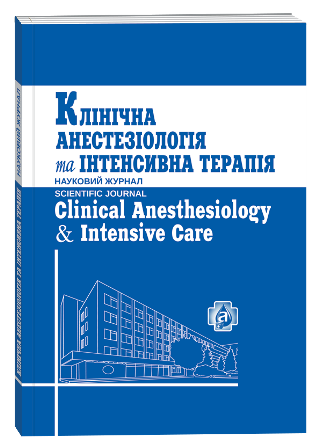CHANGES OF VEGETATIVE HEART TONUS AFTER INDUCTION OF GENERAL ANESTHESIA WITH MIDAZOLAM AND FENTANYL
DOI:
https://doi.org/10.31379/2411.2616.12.2.2Keywords:
heart rate variability, sympathetic heart tonus, parasympathetic heart tonusAbstract
Background. Administration of midazolam and fentanyl for induction of general anesthesia is often associated with cardiovascular instability. This effect can be caused by changes in the cardiac vegetative tonus induced by the drugs. There are no studies which analyzed the changes in vegetative heart tonus during induction of general anesthesia with midazolam and fentanyl. The aim of the study was to establish the changes of vegetative heart tonus in induction of general anesthesia with fentanyl and midazolam. Materials and methods. There was performed a randomized prospective study which was approved by the Ethic Committee. Written informed consent was signed by all patients. The study group involved 47 patients scheduled for surgical intervention ASA I–II. The analysis of heart rate variability and the changes in cardiac vegetative tonus was performed with Holter ECG in baseline, after premedication with fentanyl solution and after induction of general anesthesia with midazolam and fentanyl. Results of the research. After administration of fentanyl in doses of 1.0 mkg/kg for premedication there were not significant changes of heart rate variability and vegetative heart tonus. Administration of midazolam 0.2–0.3 mg/kg combined with fentanyl 1.5 mkg/kg for induction of general anesthesia leads to significative changes of HRV. There was a significative reduction of heart rate variability. The LFun (marker of sympathetic heart tonus) reduced by 24.2% (69.1 (95% CI 65.9–72.3) vs 52.4 (95% CI 62.9–70.0) (p=0.14), meantime the HFun (marker of parasympathetic cardiac tonus) enhanced by 34.9% (30.9 (95% CI 27.6–34.1) vs 47.5 (95% CI 30.4– 57.4) (p=0.01). After administration of midazolam and fentanyl for induction of general anesthesia the LFun/HFun ratio was 1.1 (95% CI 0.6–1.8) (p=0.02), signaling the enhanced parasympathetic heart tonus. Conclusions. Administration of fentanyl solution in doses 1.0 mkg/kg for premedication is not associated with semnificative changes of vegetative tonus of the heart. Administration of midazolam 0.2–0.3 mg/kg in combination with fentanyl 1.5 mkg/kg for induction of general anesthesia leads to significant decrease of heart rate variability and enhanced parasympathetic cardiac tonus.
References
Nishiyama T. Effects of premedication on heart rate variability at induction of anaesthesia: comparison between midazolam and hydroxyzine. Turk J Anaesthesiol Reanim. 2018. Vol. 46. P. 229–232.
Novel positive allosteric modulators of GABA-A receptors with anesthetic activity / M. Maldifassi et al. Sci Rep. 2016. Vol. 6, № 25943.
Anderson T. Heart rate variability: implications for perioperative anesthesia care. Curr Opin Anaesthesiol. 2017. Vol. 30, suppl. 6. P. 691–697.
HRV analysis: A free software for analyzing cardiac autonomic activity / V. Pichot et al. Front Physiol. 2016. Vol. 22, suppl. 7. P. 557.
Heart rate variability: a diagnostic and prognostic tool in anesthesia and intensive care / A. Mazzeo et al. Acta Anaesthesiol Scand. 2011. Vol. 55. P. 797–811.
Monitoring heart rate variability to assess experimentally induced pain using the analgesia nociception index / G. Jess et al. Eur J Anaesthesiol. 2016. Vol. 33. P. 118–125.
Omerbegović M. Short-term parameters of heart rate variability during balanced anaesthesia with administration of two different inhalation anaesthetics. Med Arch. 2014. Vol. 68, suppl. 4. P. 268–271.
Padley J., Ben-Menachem E. Low pre-operative heart rate variability and complexity are associated with hypotension after anesthesia induction in major abdominal surgery. J Clin Monit Comput. 2018. Vol. 32, suppl. 2. P. 245–252.
Role of heart-rate variability in preoperative assessment of physiological reserves in patients undergoing major abdominal surgery / P. Reimer et al. Ther Clin Risk Manag. 2017. Vol. 13. P. 1223–1231.
Prediction of hypotension during spinal anesthesia for elective cesarean section by altered heart rate variability induced by postural change / K. Sakata et al. Int J Obstet Anesth. 2017. Vol. 29. P. 34–38.
Midazolam more effectively suppresses sympathetic activations and reduces stress feelings during mental arithmetic task than propofol / R. Tsugayasu et al. J Oral Maxillofac Surg. 2010. Vol. 68, suppl. 3. P. 590–596.
Smith A., Owen H., Reynolds K. Can short-term heart rate variability be used to monitor fentanyl-midazolam induced changes in ANS preceding respiratory depression? J Clin Monit Comput. 2015. Vol. 29, suppl. 3. P. 393–405.
The effect of sedation during transoesophageal echocardiography on heart rate variability: a comparison of hypnotic sedation with medical sedation / Y. Dogan et al. Kardiol Pol. 2016. Vol. 74, suppl. 6. P. 591–597.
Task Force of the European Society of Cardiology and the North American Society of Pacing and Electrophysiology: Heart rate variability: standards of measurement, physiological interpretation and clinical use / Task Force of the European Society of Cardiology and the North American Society of Pacing and Electrophysiology. Circulation. 1996. Vol. 93, suppl. 5. P. 1043–1065.







